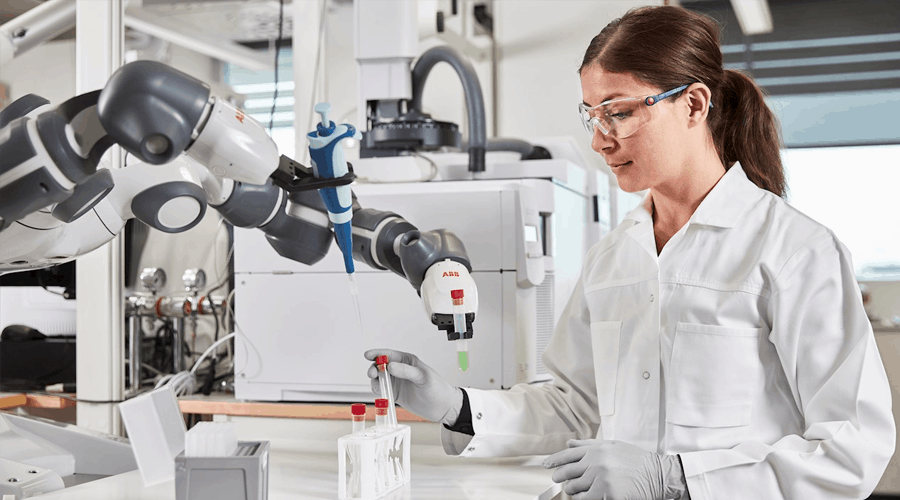Without designs inspired by the human body, these machines are now taking up the most repetitive laboratory tasks from human hands, and they will be everywhere soon.
Copyright by www.analyticsinsights.net
 Will a Laboratory Robot replace Human Workforce?
Will a Laboratory Robot replace Human Workforce?
People looking for robots in clinical laboratories are likely to miss them at first glance. It’s because today’s robots seem like Star Wars’s helpful and enterprising humanoid C-3PO character. Without designs inspired by the human body, these machines are now taking up the most repetitive laboratory tasks from human hands, and they will be everywhere soon.
Robotics manufacturer, ABB Robotics, runs a new research centre at the Texas Medical Centre (TMC) Innovation Institute in Houston, foresees that the market for nonsurgical robots in healthcare will hit 60,000 by 2025, a fourfold increase from 2018, and 5,000 of those will be for laboratories.
This inundation of robot assistants doesn’t mean they will replace humans, said Jose Manuel Collados, healthcare solutions business line manager at ABB Robotics.
“We see robots supporting in dangerous or dull activities,” Mr. Manuel said. “We are focused on supporting people.”
Here’s how robotics are being used in clinical laboratories right now.
The Existing Robotics you should know about
The concept of robotics in laboratory medicine is not new. However, this technology has advanced rapidly in the past few years.
Thank you for reading this post, don't forget to subscribe to our AI NAVIGATOR!
In 1990, clinical laboratory professionals started hearing about ‘total laboratory automation.’ “But nothing happened as of now,” stated Robin Felder, Ph.D., Professor of pathology and Associate Director of clinical chemistry and toxicology at the University of Virginia School of Medicine in Charlottesville.
Today, robotics is often used to plan the most routine and repetitive tasks of the laboratory, such as centrifuging, aliquoting, and automating routine chemistry, immunoassay, hematology, and urinalysis. The systems are mostly enabled by bar codes that indicate mechanical elements within various instruments.
Mr. Felder explains if it wasn’t routine and high volume, there was a special place in the lab where people still did things such as feed analysers manually. Robotics has already “begun to swallow up all of the manual tasks of a laboratory.”
It is possible because robotic technology is getting more sophisticated, accurate, and intelligent as artificial intelligence (AI) will gradually to secure a place in the picture. This technology is now cost-effective, making financial sense when it saves lab money on other operational expenses. For instance, a robotic arm not only can process tests without fatiguing but also can handle smaller amounts of liquid, far less than a human could.
Additionally, using smaller volumes in the reagent costs a huge chuck per volume. If you’re using a quarter or one-tenth amount of reagent, you’re saving that amount of money on raw materials costs, and robots can handle those small volumes, said Mr Felder.
Read More: www.analyticsinsights.net


Without designs inspired by the human body, these machines are now taking up the most repetitive laboratory tasks from human hands, and they will be everywhere soon.
Copyright by www.analyticsinsights.net
People looking for robots in clinical laboratories are likely to miss them at first glance. It’s because today’s robots seem like Star Wars’s helpful and enterprising humanoid C-3PO character. Without designs inspired by the human body, these machines are now taking up the most repetitive laboratory tasks from human hands, and they will be everywhere soon.
Robotics manufacturer, ABB Robotics, runs a new research centre at the Texas Medical Centre (TMC) Innovation Institute in Houston, foresees that the market for nonsurgical robots in healthcare will hit 60,000 by 2025, a fourfold increase from 2018, and 5,000 of those will be for laboratories.
This inundation of robot assistants doesn’t mean they will replace humans, said Jose Manuel Collados, healthcare solutions business line manager at ABB Robotics.
“We see robots supporting in dangerous or dull activities,” Mr. Manuel said. “We are focused on supporting people.”
Here’s how robotics are being used in clinical laboratories right now.
The Existing Robotics you should know about
The concept of robotics in laboratory medicine is not new. However, this technology has advanced rapidly in the past few years.
Thank you for reading this post, don't forget to subscribe to our AI NAVIGATOR!
In 1990, clinical laboratory professionals started hearing about ‘total laboratory automation.’ “But nothing happened as of now,” stated Robin Felder, Ph.D., Professor of pathology and Associate Director of clinical chemistry and toxicology at the University of Virginia School of Medicine in Charlottesville.
Today, robotics is often used to plan the most routine and repetitive tasks of the laboratory, such as centrifuging, aliquoting, and automating routine chemistry, immunoassay, hematology, and urinalysis. The systems are mostly enabled by bar codes that indicate mechanical elements within various instruments.
Mr. Felder explains if it wasn’t routine and high volume, there was a special place in the lab where people still did things such as feed analysers manually. Robotics has already “begun to swallow up all of the manual tasks of a laboratory.”
It is possible because robotic technology is getting more sophisticated, accurate, and intelligent as artificial intelligence (AI) will gradually to secure a place in the picture. This technology is now cost-effective, making financial sense when it saves lab money on other operational expenses. For instance, a robotic arm not only can process tests without fatiguing but also can handle smaller amounts of liquid, far less than a human could.
Additionally, using smaller volumes in the reagent costs a huge chuck per volume. If you’re using a quarter or one-tenth amount of reagent, you’re saving that amount of money on raw materials costs, and robots can handle those small volumes, said Mr Felder.
Read More: www.analyticsinsights.net
Share this: